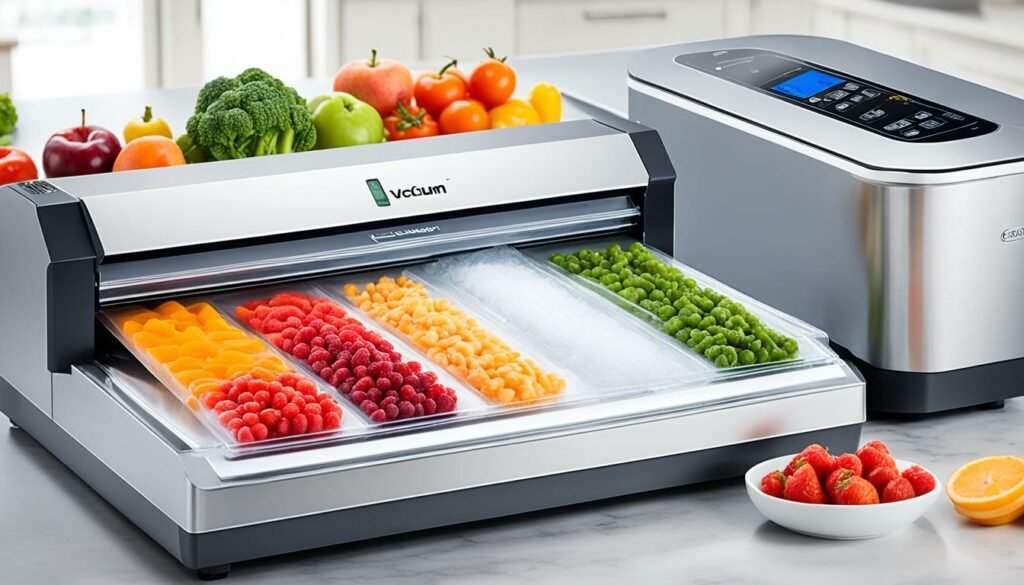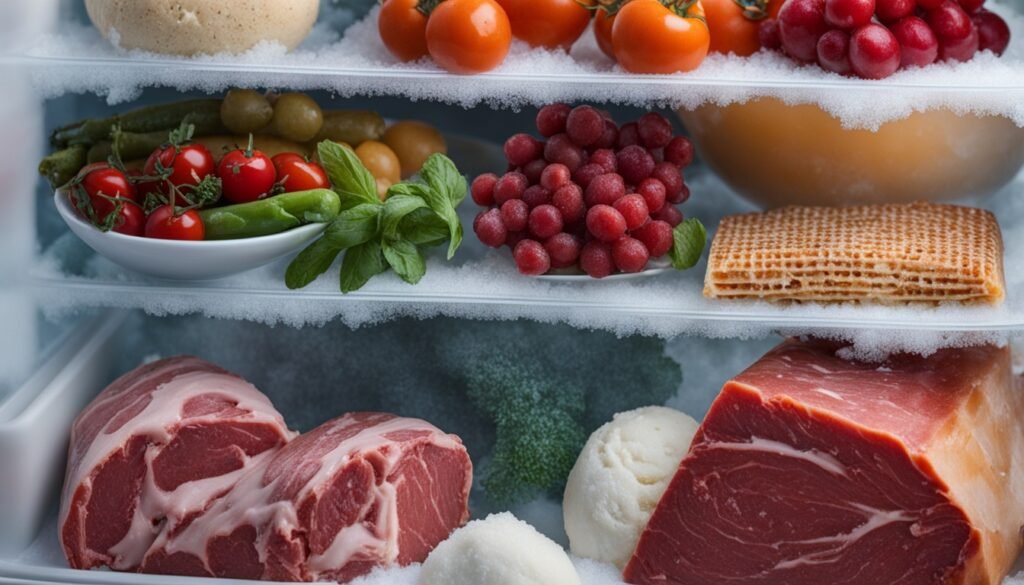I’ve always been intrigued by the best ways to keep my food fresh. Food preservation methods like vacuum sealing and freezing are often at the forefront. But which one is superior? In this article, I’ll delve into the vacuum sealing and freezing comparison to guide you in choosing the best method for extending shelf life.
Both techniques have distinct advantages, but grasping their differences is crucial. Vacuum sealing eliminates air from bags, creating a tight seal. In contrast, freezing slows down food spoilage by reducing temperatures. Let’s delve into these methods to determine which one aligns with your kitchen requirements.
Introduction to Food Preservation Methods
Food preservation methods are essential in our daily lives. They help save money and reduce waste. Let’s delve into two popular techniques: vacuum packing and freezing.
The Importance of Extending Food Freshness
Keeping food fresh is vital for its quality and nutritional value. Proper preservation methods can extend the shelf life of various foods. This includes fruits, vegetables, meats, and fish.
Here’s a quick comparison of food shelf life with and without preservation:
| Food Item | Without Preservation | With Preservation |
|---|---|---|
| Fresh Berries | 3-5 days | 1-2 weeks |
| Raw Meat | 1-2 days | 6-12 months |
| Bread | 3-7 days | 2-3 months |
Overview of Vacuum Sealing and Freezing Techniques
Vacuum packing removes air, preventing freezer burn and oxidation. It’s effective for long-term storage. Freezing, on the other hand, uses airtight containers or bags. Both methods aim to keep food quality high, but their effectiveness varies by food type.
Understanding these preservation methods helps us make better choices. We can extend food freshness and cut down on waste in our kitchens.
Understanding Vacuum Sealing Technology
Vacuum sealing technology has transformed food preservation and meal prep. It’s been a game-changer for me, allowing me to keep various foods fresh for longer and streamline my cooking. This method has significantly enhanced my culinary experience.
How Vacuum Sealers Work
Vacuum sealers eliminate air from bags, creating a tight seal. First, food is placed in a bag, then inserted into the machine. The air is removed, and a heated strip seals the bag, ensuring freshness is locked in.

Benefits of Vacuum Sealing for Food Storage
Using vacuum sealing for food storage has numerous benefits:
- Extended shelf life of foods
- Prevention of freezer burn
- Space-efficient storage
- Preservation of food quality and nutrients
- Versatility in sous vide cooking
Popular Vacuum Sealer Models and Features
I’ve evaluated several vacuum sealers and compiled a list of top performers:
| Model | Key Features | Performance |
|---|---|---|
| FoodSaver Multi-Use | Dry and moist food settings | Excellent for various food types |
| Hamilton Beach NutriFresh | Compact design | Great for small kitchens |
| Black + Decker Premium | Built-in bag cutter | User-friendly operation |
| Anova Culinary | Sous vide compatibility | Ideal for precision cooking |
These models are adept at sealing both dry and moist foods. They cater to diverse meal prep techniques and preservation needs.
Traditional Freezing Methods

Freezing techniques have been a staple for preserving food for generations. Traditional methods provide a straightforward approach to food preservation. The essence lies in utilizing airtight containers or freezer bags to maintain freshness and ward off freezer burn.
For meats and fish, I frequently employ the water-freezing method. This method involves immersing the food in water before freezing. It forms an ice barrier, safeguarding against freezer burn. Though effective, it prolongs thawing time and occupies more freezer space.
To enhance the freezing process, I adhere to these guidelines:
- Remove as much air as possible from storage bags
- Wrap food tightly in plastic wrap or foil
- Label foods with dates for easy tracking
- Use a first-in, first-out system to manage frozen inventory
For enhancing texture, especially with fish, I suggest freezing on a tray before bagging. This approach minimizes moisture, preserving the food’s original texture. While traditional freezing is dependable for storing food, it may not match the efficiency of vacuum sealing in preventing freezer burn over time.
Comparison of Vacuum Sealing and Freezing
When preserving food, the choice between vacuum sealing and traditional freezing is crucial. These methods differ significantly in their impact on food quality and storage efficiency.
Impact on Food Quality and Texture
Vacuum sealing has revolutionized food preservation, enhancing the quality of meats and vegetables. It ensures that these items retain their texture and flavor, especially when dealing with expensive food items like salmon. This method outperforms traditional freezing in preserving the integrity of the food.
Effectiveness in Preventing Freezer Burn
Freezer burn is a common issue, but vacuum sealing offers a robust solution. By eliminating air from the packaging, it creates a protective barrier. This method significantly outshines traditional freezing in preventing freezer burn.
Space Efficiency in Storage
Vacuum-sealed foods occupy less space in the freezer, promoting better organization. Thawing is also faster with these sealed items. This makes vacuum sealing a superior choice for maximizing storage space and efficiency.
FAQ
What is the main difference between vacuum sealing and traditional freezing methods?
Vacuum sealing removes air from the packaging, creating an airtight seal. This helps prevent freezer burn and extends shelf life. Traditional freezing methods store food in airtight containers or freezer bags, sometimes with water for items like fish.
How do vacuum sealers work?
Vacuum sealers remove air from bags and seal them airtight with a heated strip. This limits oxygen exposure, preserving food quality and preventing spoilage.
What are the benefits of vacuum sealing food?
Vacuum sealing extends shelf life, prevents freezer burn, and optimizes storage space. It also preserves food quality and texture better than traditional freezing methods.
Which vacuum sealer models are recommended?
Consumer Reports recommends models like the FoodSaver Multi-Use, Hamilton Beach NutriFresh, Black + Decker Premium Vacuum Sealer, and Anova Culinary Vacuum Sealer for their performance.
How can I maximize the effectiveness of traditional freezing methods?
Improve traditional freezing by removing air from bags or wrapping food tightly in plastic or foil. Use dates on labels and a first-in, first-out inventory system to manage your frozen food.
Is vacuum sealing or freezing better for preserving fish?
Vacuum sealing preserves fish flavor and texture better than freezing in water, especially for salmon. Wrap fish with sharp edges in butcher paper before sealing to avoid bag punctures.
